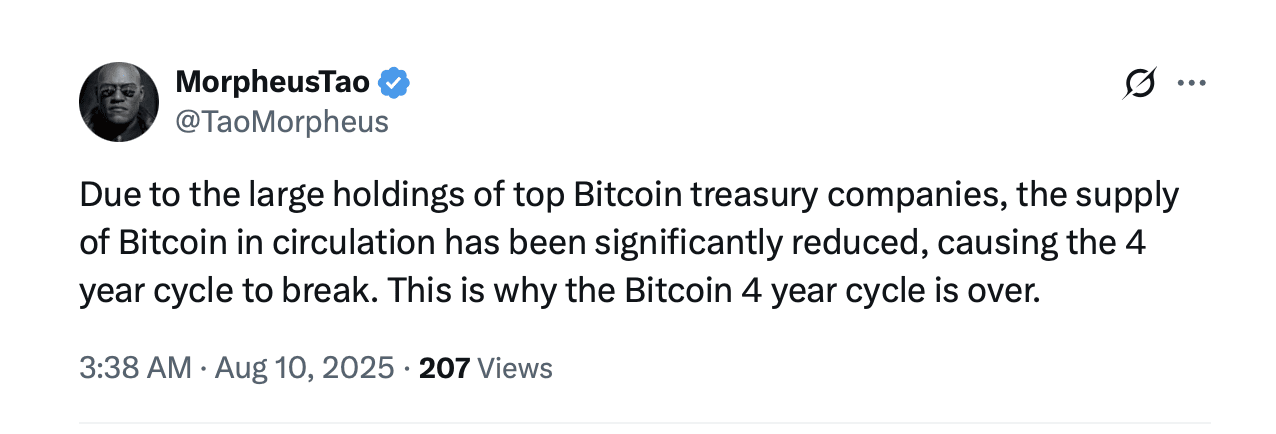In the cryptocurrency market, theories can evolve as rapidly as dust devils, and recently, a particular hypothesis has gained popularity — that bitcoin's famous four-year cycle may have ended. Proponents of the "the cycle is dead" trend argue that the model is unraveling, citing changes such as increased institutional participation, the emergence of ETFs, moves towards clearer regulation, and the steady accumulation by governments and large corporations.
The End of an Era? Cryptocurrency Advocates Claim Bitcoin's Famous Cycle Has 'Died'
Since Bitcoin's inception, its native currency has followed a familiar four-year rhythm driven by the halving event — the event that cuts mining rewards in half every four years. This shift has often triggered a chain reaction: a price surge, a sharp drop into bear market territory, and then a gradual recovery before the next halving restarts the process. In the past, this cycle has pushed bitcoin's price higher after each halving before a sharp decline, but this time, many believe the pattern may not repeat.

Matthew Hougan, chief investment officer at Bitwise Asset Management, told CNBC earlier this week that he believes the cycle has ended. "It won’t officially end until we see positive returns in 2026. But I think we will see that, so let's put it this way: I think the 4-year cycle has ended," Hougan detailed. The debate has also spread to social platforms like Reddit and X. On X, the account Simplifying Stocks, CPA claimed, "The 4-year cycle of Bitcoin is dead. Why?"
The X account then provided its own answer:
"ETFs: buy. Retail: buy. Institutions: buy. Treasury companies: buy. Government: buy. 401k: coming to buy. Pension funds: coming to buy. Higher SIGNIFICANT."
A growing group of influencers, analysts, and media claim that the cycle is outdated, pointing to the evolution of bitcoin into a mainstream institutional asset. While some still disagree, many support this idea with data and reasonable arguments. Some predict that a "prolonged bear market" is still far off, and one user confidently stated, "we will go as far as Q2/Q4 of 2026, depending on factors like global liquidity."
Conversely, the X account Crypto Dad opposes the popular notion that bitcoin's four-year cycle has ended due to the acceptance of institutions.
In a detailed post, Crypto Dad argued that the cycle is not just a product of halving events as many think, but instead, it is deeply tied to the global liquidity cycle — a model running at a pace of about four to five years that has been reset by the 2008 financial crisis.
According to the post, bitcoin's past all-time highs have coincided with global liquidity peaks, not just halving events, indicating that "QE1–QE3, ZIRP" fueled the 2009–2013 bull run, the spillover of QE for 2014–2017, and QE during the pandemic for 2018–2021.
The post concludes with:
"Halving is the spark. Global liquidity is the oxygen. The 4-year rhythm does not stem from the Bitcoin code — it stems from the reshaping of currency after 2008. If you only look at halving, you will miss the real clock."
On July 23, crypto influencer Marty Party told 226,000 followers on X, "Bitcoin Basics 2025—The 4-year cycle is long gone. The 2020 bear market was created by the government beforehand to try [to] stop bitcoin. It has failed. Bitcoin is absorbing fiat at least until 2050. The new administration has agreed. The system is shifting to hard currency. This is a good thing. It will solve all our problems."
The ongoing debate not only reflects a contrasting view of the data — it highlights a shift in how market participants define the future of bitcoin. With narratives now shaped as much by macroeconomic policy as by blockchain mechanics, the community is facing a challenge: to adapt to evolving signals or cling to a model formed in the asset's early years, when it was less organized.
As debates become heated, the market itself may ultimately render a final verdict. Whether driven by liquidity flows, halving sparks, or new layers of acceptance, bitcoin’s price action in the coming years may speak louder than any theory. Until then, traders and analysts remain in a state of wait, watching to confirm that one of the oldest models in the crypto world has indeed come to an end.
